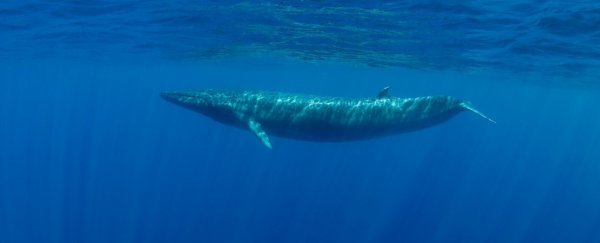A new type of whale song may very well belong to a previously unknown population of blue whales, peacefully swimming in the Indian Ocean.
The unusual song was picked up at three different underwater locations separated by 3,500 kilometres (2,175 miles) of ocean. First recorded in 2017 off the coast of Madagascar, these unique calls were later identified in the western Arabian Sea, off the coast of Oman, and also in the Chagos Archipelago in the central Indian Ocean.
Before now, this region was thought to harbour just a single population of blue whales (Balaenoptera musculus), distinguished by its own unique call. Any whales found in this area were simply assumed to be part of that population. But these new sounds didn't match up.
Instead, the songs indicate there are at least two populations in this ocean with either distinct or partially overlapping distributions. Given that whale songs are extensively studied on a global scale, finding something new is an exciting day for scientists.
"It was quite remarkable to find a whale song in your data that was completely unique, never before reported, and recognise it as a blue whale," says Salvatore Cerchio, Director of the African Aquatic Conservation Fund's Cetacean Program.
"With all that work on blue whale songs, to think there was a population out there that no one knew about until 2017, well, it kind of blows your mind."
Taking a remotely recorded call and trying to match it to an individual whale species, let alone a specific population, is difficult work. Yet even without visual or genetic data, researchers are relatively confident that some, if not all, of these new recordings belong to a previously unidentified population of blue whales.
Through careful comparison, the team has concluded the sounds do not match any other local whale candidate. What's more, within hours of the whale song reaching microphones off the coast of Oman, there were local sightings of blue whales.
While the structure of the calls is reminiscent of other blue whale songs, producing low frequency, regularly spaced repetitions of a single phrase, it still shows unique attributes.
"Given the acoustic attributes of the new song-type reported here, and the documented close proximity of a blue whale to our recorder off Oman when these songs were recorded, we conclude that these songs were almost certainly produced by a blue whale," the authors write.
Blue whales are thought to be amongst the largest animals to have ever lived on Earth. The fact that we are still finding new populations speaks to the vastness of the ocean and the relentless cruelty of their killing.
Nearly hunted to extinction in the 20th century, it wasn't until the International Whaling Commission banned the practice in 1967 that blue whales got a break.
In fact, this new population off the coast of Oman could still be recovering from historic hunting. In the 1960s, the Soviet Union partook in intensive illegal whaling in this region, killing 1,294 blue whales in total, according to the team's paper.
Based on national catch data, the researchers suggest this newly heard population is likely what the Soviet hunters were once targeting.
"Moreover, the potentially restricted range, intensive historic whaling, and the fact that the song-type has been previously undetected, suggests a small population that is in critical need of status assessment and conservation action," they write.
If that's true, these whales need our attention and protection. Very rarely spotted off the coast of Oman, it seems as though they are struggling. Similar to other blue whales, they are probably threatened by fisheries activity, shipping, fossil fuel exploration and production, and coastal development.
"For 20 years we have focused work on the highly endangered Arabian Sea humpback whale, for which we believe only about 100 animals remain off the coast of Oman," says Suaad Al Harthi, Executive Director of the Environment Society of Oman.
"Now, we are just beginning to learn more about another equally special, and likely equally endangered, population of blue whale."
Further recordings off the coast of Oman, Pakistan and northern India could help verify if these blue whales do indeed belong to a newly identified population. Especially if visual or genetic data can be gathered.
Underwater microphones placed elsewhere in the Indian Ocean would also help reveal the true range of this new population and its possible migration patterns.
If this is a new population, it's vital we understand how these whales are doing so we can ensure their survival.
The study was published in Endangered Species Research.
